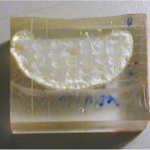
Photo-cured dental composites are the most commonly placed dental restorative material. A commercial dental composite consists of a mixture of dimethacrylate monomers (resins) with up to 80% by weight of silane-coated, inorganic filler particles with an average size typically ranging from 40-4000nm. The composite paste is incrementally packed into a cavity preparation and the dentist exposes each increment for 20-40 seconds to intense visible blue light. The light activates a chemical initiator within the composite and the resin monomers undergo free radical addition polymerization via their vinyl groups, turning the paste into a durable, solid restorative material.
A critical feature of a photo-cured polymer is the degree of conversion (DC), since this affects the properties of the composite restoration (e.g., shrinkage, adhesion, hardness). The DC is the fraction of the number of carbon double bonds that react during the polymerization, and typically is in the range of 50-70% for dental composites. Studies have shown the importance of the degree of conversion and depth of cure on the performance of composite restorations both in vivo and in vitro. The DC is affected by many factors, including those related to the composite formulation (monomer type, filler type, composition and size distribution, photosensitizer/accelerator/inhibitor type and concentration), the illumination (output spectra, power, time of illumination) and the curing environment (geometry of the specimen, distance from the light source, color of the backing material).
The literature contains a number of studies addressing the levels of irradiance and duration needed to cure composites to varying depths. However, these empirically derived parameters must be established for each new curing light or composite formulation and provide little insight into the curing process for light-scattering composites. This need to refigure parameters for each situation affects the clinician's ability to optimize the quality of a given restoration and the manufacturer's ability to develop new composites which address problems of shrinkage, esthetics, and adhesion.
Not all the light absorbed by the composite is equally effective at inducing polymerization. There are three primary absorbers in the composite: the initiator (photosensitizer), the monomer/comonomer resin, and the tint added to achieve the correct tooth shade. Only the light absorbed by the initiator will be used in the photo-curing process; the other absorbed light is lost to heat. Furthermore, absorption by the initiator drops during the curing process as the initiator is incorporated into the polymer chain and stops absorbing light. The index of refraction of the resin matrix also changes during polymerization, which in turn affects the scattering by the filler particles and the overall scattering coefficient of the composite.
In collaboration with Jack Ferracane we are measuring the changes in optical properties of dental composites during curing and developing dynamic computer models that emulate the curing process.
2012L. J. Schneider, L. A. Cavalcante, S. A. Prahl, C. S. Pfeifer, J. L. Ferracane, "Curing efficiency of dental resin composites formulated with camphorquinone or trimethylbenzoyl-diphenyl-phosphine oxide," Dental Materials, 28, 392-397 (2012).
2011H. Davis, S. A. Prahl, J. L. Ferracane, "Reciprocity in Dental Resins and Composites," IADR/AADR/CADR 89th General Session, 90A, (2011, poster).
S. A. Prahl, C. Y. Chen, V. Keränen, J. L. Ferracane, "Dynamic Optical Properties of Dental Composites," IADR/AADR/CADR 89th General Session, 90A, (2011, abstract only).
2010L. F. Schneider, L. M. Cavalcante, S. A. Prahl, J. Ferracane, "Trimethylbenzoyl-diphenyl-phosphine Oxide as Photoinitiator in Dental Resins and Composites," IADR/AADR/CADR 88th General Session, 89A, (2010 abstract only).
2008L. F. J. Schneider, C. S. C. Pfeifer, S. Consani, S. A. Prahl, J. L. Ferracane, "Influence of photoinitiator type on the rate of polymerization, degree of conversion, hardness and yellowing of dental resin composites," Dental Materials, 24, 1169-1177 (2008).
2007Y.-C. Chen, J. L. Ferracane, S. A. Prahl, "Quantum Yield of Conversion of the Photoinitiator Camphorquinone," Dental Materials, 655-664 (2007).
2005Y.-C. Chen, J. L. Ferracane, S. A. Prahl, "A Dynamic Monte Carlo Model for Predicting Radiant Exposure Distribution in Dental Composites: model development and verifications," Lasers in Dentistry XI, 5687, 90-101 (2005).
Y.-C. Chen, J. L. Ferracane, S. A. Prahl, "A pilot study of a simple photon migration model for predicting depth of cure in dental composite," Dental Materials, 21, 1075-1086 (2005).